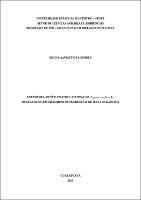| Compartilhamento |


|
Use este identificador para citar ou linkar para este item:
http://tede.unicentro.br:8080/jspui/handle/tede/408| Tipo do documento: | Dissertação |
| Título: | ESTRUTURA GENÉTICO-POPULACIONAL DE Eugenia uniflora L. (MYRTACEAE) EM FRAGMENTOS FLORESTAIS DE MATA ATLÂNTICA |
| Título(s) alternativo(s): | Population genetic structure of Eugenia uniflora L. in forest fragments of Atlantic Forest |
| Autor: | Fagundes, Bruna Saviatto  |
| Primeiro orientador: | Silva, Paulo Roberto da |
| Primeiro coorientador: | Faria, Marcos Ventura |
| Resumo: | A redução de habitats naturais contribui para a perda de biodiversidade e para o isolamento das populações remanescentes. Uma espécie vegetal com grande representatividade na Mata Atlântica é a Eugenia uniflora L., também conhecida como pitangueira. Objetivando investigar os efeitos da fragmentação florestal na estrutura genética de populações naturais de Eugenia uniflora, sete loci ISSR e nove loci SSR foram amplificados em três populações de fragmentos de Floresta Ombrófila Mista. O coeficiente médio de similaridade entre as populações A, C e D foi de 0,31. A similaridade genética entre os indivíduos da população mais isolada (0,42) foi maior que a similaridade encontrada entre os indivíduos das populações C (0,34) e D (0,36) que, por sua vez, estão conectadas. O agrupamento de todos os indivíduos formou três grupos correspondentes a cada população estudada. Uma alta diferenciação genética foi observada entre as três populações (FST = 0,34; I = 0,51), sendo que dentro das populações a diferenciação foi maior do que entre as populações, correspondendo a 71,33% e 28,67% respectivamente. A média da diversidade genética dentro das populações (Ho = 0,33; He = 0,47) indica uma deficiência de heterozigotos pelo aumento dos cruzamentos endogâmicos (Fi = 0,29) e constitui uma resposta à redução do fluxo gênico (Nm = 0,48). De acordo com o agrupamento da distância genética de Nei (1978), a população A e D foram as mais distantes geneticamente. A redução da variabilidade genética da espécie nessas áreas fragmentadas poderá, futuramente, alterar a capacidade adaptativa de E. uniflora às mudanças ambientais e interferir na dinâmica de comunidade de espécies associadas. |
| Abstract: | The reduction of natural habitats contributes to the lost of biodiversity e to the isolation of the remaining populations. A plant species that has great representativeness in the Atlantic forest is the Eugenia uniflora L., also known as Surinan cherry tree. Intending to investigate the effects of the forest fragmentation in the genetic structure of natural populations of Eugenia uniflora, nine loci SSR and seven loci ISSR were amplified in three Rain Forest fragment populations. The similarity average coefficient between the A, C and D was of 0,31. The genetic similarity among the individuals of the most isolated population (0,42) was bigger than the one found among the populations C (0,34) and D (0,36), which, on the other hand, are connected. The grouping of all the individuals formed three groups corresponding to each studied population. A high genetic diversity was observed among the three populations (FST = 0,34; I = 0,51), and the differentiation was bigger inside the population than among them, corresponding to 71,33% e 28,67% respectively. The genetic diversity average inside the populations (Ho = 0,33; He = 0,47) indicates a deficiency of heterozygotes by the increase of endogamous crossing (Fi = 0,29) and constitutes an answer to the gene flow reduction (Nm = 0,48). According to the grouping of Nei`s genetic distance (1978), population A and D were the most genetically distant. The species genetic variability reduction on these fragmented areas may change the E. uniflora adaptive capacity to environmental changes and interfere with the community dynamic of associated species. |
| Palavras-chave: | Fragmentação florestal Conservação SSR ISSR Pitanga Forest fragmentation Conservation SSR, ISSR Surinan cherry |
| Área(s) do CNPq: | CIENCIAS BIOLOGICAS::BIOLOGIA GERAL |
| Idioma: | por |
| País: | BR |
| Instituição: | UNICENTRO - Universidade Estadual do Centro Oeste |
| Sigla da instituição: | UNICENTRO |
| Departamento: | Unicentro::Departamento de Biologia |
| Programa: | Programa de Pós-Graduação em Biologia Evolutiva (Mestrado) |
| Citação: | FAGUNDES, Bruna Saviatto. Population genetic structure of Eugenia uniflora L. in forest fragments of Atlantic Forest. 2013. 46 f. Dissertação (Mestrado em Biologia Evolutiva) - UNICENTRO - Universidade Estadual do Centro Oeste, Guarapuava, 2013. |
| Tipo de acesso: | Acesso Aberto |
| URI: | http://localhost:8080/tede/handle/tede/408 |
| Data de defesa: | 20-Fev-2013 |
| Aparece nas coleções: | Programa de Pós-Graduação em Biologia Evolutiva |
Arquivos associados a este item:
| Arquivo | Descrição | Tamanho | Formato | |
|---|---|---|---|---|
| PR BRUNA SAVIATTO FAGUNDES.pdf | 1,02 MB | Adobe PDF |  Baixar/Abrir Pré-Visualizar |
Os itens no repositório estão protegidos por copyright, com todos os direitos reservados, salvo quando é indicado o contrário.




